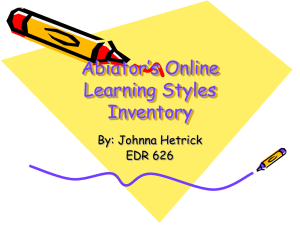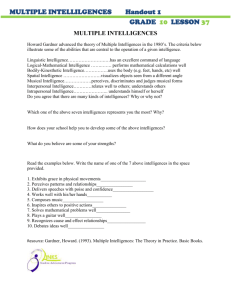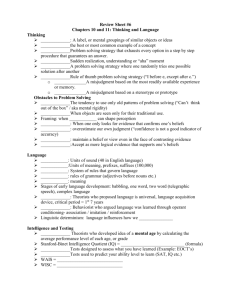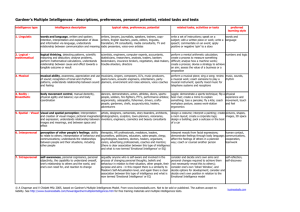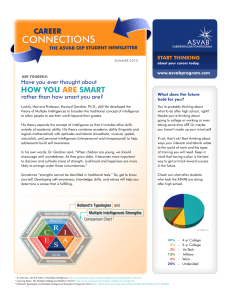Learning Styles Information
advertisement
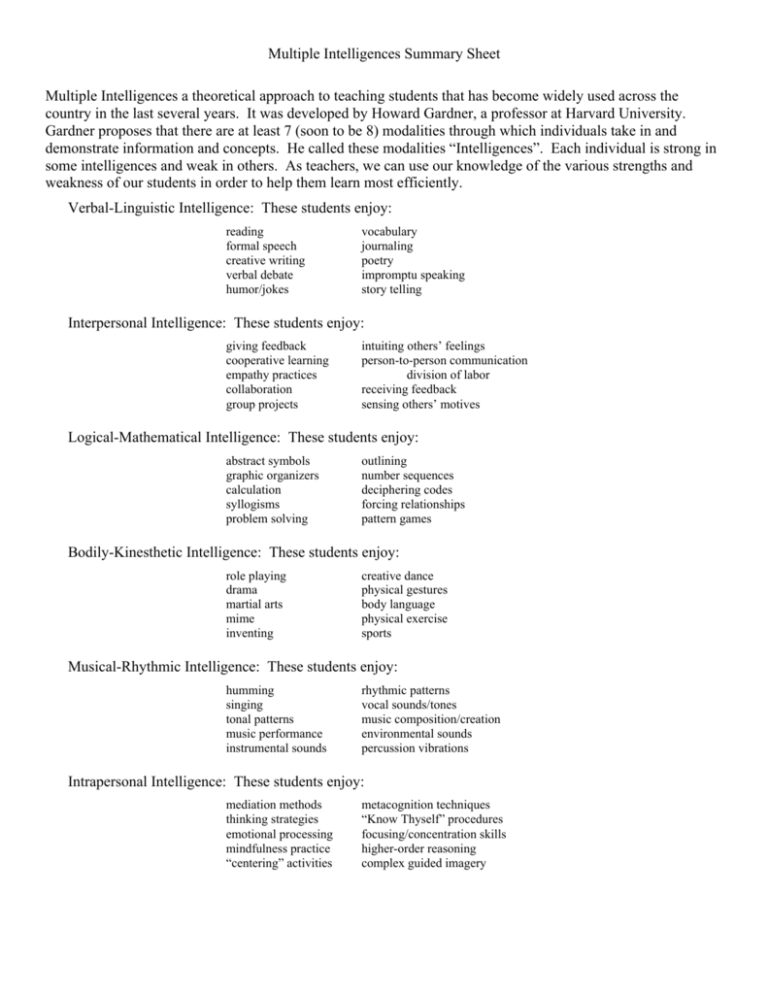
Multiple Intelligences Summary Sheet Multiple Intelligences a theoretical approach to teaching students that has become widely used across the country in the last several years. It was developed by Howard Gardner, a professor at Harvard University. Gardner proposes that there are at least 7 (soon to be 8) modalities through which individuals take in and demonstrate information and concepts. He called these modalities “Intelligences”. Each individual is strong in some intelligences and weak in others. As teachers, we can use our knowledge of the various strengths and weakness of our students in order to help them learn most efficiently. Verbal-Linguistic Intelligence: These students enjoy: reading formal speech creative writing verbal debate humor/jokes vocabulary journaling poetry impromptu speaking story telling Interpersonal Intelligence: These students enjoy: giving feedback cooperative learning empathy practices collaboration group projects intuiting others’ feelings person-to-person communication division of labor receiving feedback sensing others’ motives Logical-Mathematical Intelligence: These students enjoy: abstract symbols graphic organizers calculation syllogisms problem solving outlining number sequences deciphering codes forcing relationships pattern games Bodily-Kinesthetic Intelligence: These students enjoy: role playing drama martial arts mime inventing creative dance physical gestures body language physical exercise sports Musical-Rhythmic Intelligence: These students enjoy: humming singing tonal patterns music performance instrumental sounds rhythmic patterns vocal sounds/tones music composition/creation environmental sounds percussion vibrations Intrapersonal Intelligence: These students enjoy: mediation methods thinking strategies emotional processing mindfulness practice “centering” activities metacognition techniques “Know Thyself” procedures focusing/concentration skills higher-order reasoning complex guided imagery Visual-Spatial Intelligence: These students enjoy: visualization color schemes painting pretending sculpture active imagination patterns/designs drawing mind mapping visual pictures The concept of multiple intelligence is also very effective in designing alternative assessments that allow students to really demonstrate what they know. Verbal-Linguistic Assessments essays vocabulary quizzes recall of verbal info audiocassette recording writing poetry linguistic humor formal speech debates listening and reporting logs and journals Logical-Mathematical Assessments cognitive organizers higher-order reasoning pattern games/tests outlining logic/rationality exercises mental menues/formulas deductive reasoning problems inductive reasoning problems calculations logical analysis and critique Musical-Rhythmic Assessments creating concept songs/raps illustrating with sound discerning rhythmic patterns composing music linking music/rhythm with concepts orchestrating music recognizing patterns and quality analyzing musical structure Interpersonal Assessments group “jigsaws” explaining think-pair-share round robin activities giving/receiving feedback interviews/questionnaires random group quizzes assessing teammates test-coach-retest empathetic processing Bodily-Kinesthetic Assessments lab experiments dramatization original dance charades/mimes impersonations human tableaux invention projects skills demonstrations physical games/exercises illustration using their bodies Intrapersonal Assessments autobiographical reporting personal application scenarios surveys and questionnaires higher-order questions/answers concentration tests diaries and logs personal projection personal history correlation Learning Styles in Brief Modality Strengths Learn Best By: Visual Learn by observation Can recall what they’ve seen Can follow written or drawn instructions Likes to read Use written notes Charts, graphs and diagrams Sight words Visual similarities and differences Pictures and graphics Maps Silent reading Auditory Learn by listening Can recall what they’ve heard Can follow oral directions Use oral language effectively Discussion and dialogue Memorization Phonics Oral reading Hearing anecdotes or stories Tactile Learn by touching and manipulating objects Can follow directions they’ve written themselves Mechanical tasks Building models Art-type projects Using manipulatives Drawing Writing/tracing Designing things Kinesthetic Learn through physical activity Learn through experience Can follow direction that they’ve rehearsed Are often physically adept Playing games Role playing Drama Building models Memorizing/learning while moving (pacing, stationary bike, finger or whole-body games...) Global Makes decisions based on emotion and intuition Less concerned with tidiness and order Spontaneous and creative Often a risk-taker An “idea” person Analytic Project STAY – 1999 Makes decisions based on logic Well organized and plan oriented Detail oriented Stories and anecdotes Seeing the “whole” rather than individual parts Highly interesting project and materials Functional games and activities Sequentially organized material Moving from the “part” to the “whole” Puzzles, logic games Teacher-directed activities with clearly defined goals and procedures Analytical or Global When it comes to... Analytical thinkers tend to prefer.. 1. Sound 2. Light 3. Room Temperature Silence for concentrating Some sound for concentrating Bright light for reading/studying Very low light for reading/studying Turning the thermostat warmer; wearing Turning the thermostat cooler: heavy clothing wearing lightweight clothing Studying at a desk and chair Studying on a bed or floor Sitting still for long periods of time Moving around constantly Learning in the morning; going to bed Learning later in the day; staying early up late (a night owl) Eating breakfast and regular meals Skipping breakfast; snacking while learning. Working alone or under the direction Working in group or peer learning; of one other person; being self-directed, discovering answers rather than independent being told Working on one job at a time until done; Starting more jobs than they can being somewhat compulsive complete; procrastinating Making lists for everything; planning far Doing things when they “feel like ahead; putting tasks on a calendar; it”; not planning ahead, but rather avoiding risk taking “going with the flow”; experimenting; trying things out Taking a long time to make decisions; Being spontaneous in making second-guessing decisions decisions; doing what “feels right” Punctuality; wearing watches with large Running late; wearing fashion numbers watches with few or no numbers Neat, well-organized appearance; outfits Disorganized appearance; clothes that go together may not match Seeing things as they area at the moment; Seeing things as they might be; noticing details perceiving the whole; ignoring details Following directions step-by-step; Studying a picture of how starting over if they “get stuck” something will look when complete, then assembling it their way Logically, analytically, sequentially; Intuitively and randomly; seeing seeing cause and effect; perceiving similarities and connections; differences; figuring out things stepworking backwards from whole to by-step; understanding symbolic codes parts from concrete to symbolic Sequential tasks and concrete, logical Learning through open-ended steps tasks; creating new ideas; learning through simile and metaphor Remembering what has been spoken Remembering images of what has been seen and experienced Predictable test formats (multiple Opportunities to express choice, true-false, essay) themselves in ways other than writing 4. Furniture 5. Mobility 6. Time of day 7. Eating 8. Learning 9. Tasks 10. Planning 11. Deciding 12. Time 13. Neatness 14. Perceiving 15. Assembling 16. Thinking 17. Learning 18. Remembering 19. Taking tests Global thinkers tend to prefer... From TEACHING KIDS WITH LEARNING DIFFICULTIES IN THE REGULAR CLASSROOM by Susan Winebrenner, Free Spirit Publishing Inc., page 44. This page may be photocopied. Learning Styles Summary Sheet Probably the most notable research on individual learning styles has been done by Dr. Rita Dunn. In 1967, she developed a learning styles model that has since been extensively researched and implemented in schools and classrooms around the world. The concept behind the model involves figuring out how a student best understands, remembers and uses information and then choosing instructional strategies that teach to those strengths. A student’s strengths, weaknesses and preferences are assessed in the following 5 areas. Environmental Style - Does the student learn best when he/she: • works in silence or with music/background noise... • is cool or warm • works in bright light or dim light • is in a formal or informal setting Emotional Style - Does the student learn best when he/she: • is internally or externally motivated • is a leader or a follower • is in a structured or unstructured environment Sociological Style - Does the student learn best when he/she works: • with peers • by him/herself • with an adult • in a varied setting Physical Style - Does the student learn best when information is presented in: • an auditory modality (hearing) • a visual modality (sight) • a tactile modality (needing to touch objects) • a kinesthetic modality (needing to move) • a combination of modalities Psychological Style - Does the student learn best when information is presented: • analytically (parts to the whole) or globally (whole to the individual parts) • to the right hemisphere of the brain or the left • in a way that allows him/her to process impulsively or reflectively Once a profile is developed, instructional strategies can be chosen. For example, phonics is a good way to teach reading to students who are auditory-analytical learners but it is not as effective with visual- or tactile/kinesthetic-global learners. That doesn’t mean that we don’t use phonics at all with these students (the auditory modality can be strengthened to varying degrees depending on the individual). It simply means that, these students may benefit most from a more language-experience (whole language) or sight word program. For additional information write: National Reading Styles Institute PO Box 39 Roslyn Heights, NY 11577 1-800-331-3117 Scholastic PO Box 7502 Jefferson City, Mo 65102 Or check out these references: Strategies for Education Diverse Learners, Dunn, Rita, 1995. Wright Group 10949 Technology PL San Diego, Ca 92127 How to Implement and Supervise a Learning Style Program, Dunn, Rita. Learning Styles: Personal Exploration and Practical Applications, An Introduction to Style for Secondary Students, Butler, Kathleen. Learning Styles and Performance Assessment, Prewitt, Bobby. The North Carolina Education Place website This site has a couple of sections devoted to learning styles. Seven Kinds of Learning Styles for Multiple Intelligences Children who are strongly: Linguistic Think in words Love Need reading, writing, telling stories, playing word game, etc. books, tapes, writing tools, diaries, dialogue, discussion, debate, stories, etc. things to explore, science materials, manipulatives, science and nature trips, etc. art, LEGOs, videos, imagination games, mazes, puzzles, trips to the art museum, illustrated books, etc. role play, drama, movement, things to build, sports, tactile experiences, handson learning, etc. sing-along time, concerts, music playing at home and school, musical instruments, etc. friends, group games, social gatherings, community events, clubs, mentor/apprenticeships, etc. secret places, time alone, self-paced projects, choices, etc. experimenting, questioning, figuring out logic puzzles, calculating, etc. designing, drawing, visualizing, doodling, etc. LogicalMathematical by reasoning Spacial in images and pictures BodilyKinesthetic through somatic sensations dancing, running, jumping, building, touching, gesturing, etc. Musical via rhythms and melodies singing, whistling, humming, tapping hand and feet, listening, etc. Interpersonal by bouncing ideas off of other people leading, organizing, relating, manipulating, meditating, partying, etc. Intrapersonal deeply inside of themselves setting goals, meditating, dreaming, being quiet, planning Summary of the “Seven Ways of Teaching” Intelligence Linguistic LogicalMathematical Spacial BodilyKinesthetic Musical Interpersonal Intrapersonal Teaching Activity (examples) Teaching Materials (examples) Instructional Strategies lectures, discussions, word games, storytelling, choral reading, journal writing, etc. brain teasers, problem solving, science experiments, mental calculation, number games, critical thinking, etc. visual presentations, art activities, imagination games, mind-mapping, metaphor, visualization, etc. hands-on learning, drama, dance, sports that teach, tactile activities, relaxation exercises, etc. superlearning, rapping, songs that teach books, tape recorders, word processor, stamp sets, books on tape, etc. calculators, math manipulatives, science equipment, math games, etc. read about it, write about it, talk about it listen to it cooperative learning, peer tutoring, community involvement, social gatherings, simulations, etc. individualized instruction, independent study, options in course of study, self-esteem building, etc. quantify it, think critically about it, conceptualize it graphs, maps, video, see it, draw it, LEGO sets, art visualize it, color it, materials, optical mind-map it illusions, cameras, picture library, etc. building tools, clay, sports equipment, manipulatives, tactile learning resources, etc. tape recorder, tape collection (or CDs), musical instruments, etc. board games, party supplies, props for role plays, etc. build it, act it out, touch it, get a “gut feeling” of it, dance it self-checking materials, journals, materials for projects, etc. connect it to your personal life, make choices with regard to it sing it, rap it, listen to it teach it, collaborate on it, interact with respect to it Multiple Intelligences Self Profile Directions: Read each statement. Use the scale below and give each statement a number that best represents response. 1= Not at all like me 2= A little like me 3= Somewhat like me 4= A lot like me 5= Definitely me Section 1 a. b. c. d. e. I have a deep sense of awareness of inner feelings, strengths and weaknesses. I have a strong sense of independence, strong will and am self-directed. I prefer my own private world/time to large group functions. I like to be alone to pursue personal hobbies, interests or projects. I have a deep sense of self confidence. Total Section 2 a. b. c. d. e. I like being with people more than being alone. I have many friends. I enjoy socializing in a variety of environments. I learn best through cooperative activities. I am good at communication, organizing and sometimes even manipulating people. Total Section 3 a. b. c. d. e. I learn best by moving, touching and/or acting out information. I process most of my knowledge through sensations. I have well defined ability in fine and gross motor skills. I enjoy taking things apart and putting them back together. I can mimic other people’s mannerisms well. Total Section 4 a. b. c. d. e. I enjoy reading, writing and listening. I enjoy jokes, tall tales and stories. I easily remember names, places, dates and other trivia. I can spell accurately and have a highly developed vocabulary. I like crossword puzzles or playing word games. Total Section 5 a. b. c. d. e. I like to explore patterns, categories and relationships of information. I can compute math problems easily and quickly. I can group, order, analyze, interpret and predict data. I enjoy strategy games (e.g. chess) and like to win. I ask a lot of questions about how things work. Total your Section 6 a. b. c. d. e. I think in images and pictures. I like to draw, paint, sculpt and engage in other art activities. I use clear visual images when thinking about concepts and explaining information. I can draw accurate representations of people or things. I tend to daydream when learning new information. Total Section 7 a. I am highly aware of sounds within the environment. b. I typically play music when working or relaxing. c. I can easily remember melodies of songs. d. I generally know when music or a note is off key. e. I like to sing, hum and keep rhythm. Total To determine your most prevalent intelligence, complete the following steps: 1. Add the scores for each section and place the number on the “total” line for that section. 2. Take the total score from each section and mark the score on the graph. Color in the area below the score to develop a picture of which intelligence(s) appears your area of strength or preference. Intelligence Scoring Graph Total 25 23 21 19 17 15 13 11 9 7 5 3 1 Section 1 Section 2 Section 3 Section 4 intrapersonal interpersonal bodyily kinesthetic linguistic Developed by Anne Moll, KDE Section 5 mathemati cal/logical Section 6 visual spacial Section 7 musical to be
